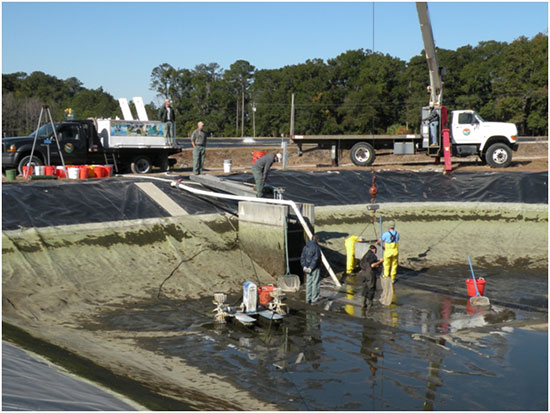Sustainable Pond Management Practices
Research has demonstrated that intensive striped bass hybrids and shrimp growout ponds can be operated with much reduced water exchange rates without affecting production. Up to 7,000 kg/ha of shrimp and 13,640 kg/ha of fish have been produced with no water exchange except for that which occurs through excessive precipitation. These production levels exceed the average commercial production goals; however, some commercial farms are now targeting higher production and ponds are typically drained at harvest.

One way to increase the production capability of no-exchange systems is through sludge management. Techniques to concentrate sludge in confined deposition areas and automatically remove it have been designed. Alternate disposal options, such as high land application to improve impoverished soil, are being investigated.
For short annual crops like shrimp, it may be possible to rejuvenate water through the fallow winter period and reuse it the next season. Harvesting techniques which do not require that the water be discharged are being developed. In addition to eliminating the harvest effluent, the pond develops a rich community of shrimp forage items through the winter, an aquatic pasture of sorts and abundant live prey increase shrimp growth rates the following spring.
WMC continues to refine and integrate these various techniques to reduce environmental impacts. A hypothetical sustainable marine aquaculture system based on pond systems with negligible communication with the estuary can be devised.
WMC research also addresses engineering aspects of aquaculture such as design and maintenance of aquaculture equipment and facilities in the harsh saltwater environment. Thirty plus years of exposure to this environment has taken its toll on WMC facilities and taught some valuable lessons as well. Of particular concern is the aeration equipment required to maintain large super-intensive production ponds.
Aeration equipment on the market is generally suited to freshwater (such as that used in the catfish industry) or very small saltwater units (such as that used in Asian shrimp farms). Specifications and operating procedures for saltwater paddlewheels in the 5 to 10 hp range are being continually refined.
Other engineering projects include sludge handling as part of the environmental impact elimination work and water filtration, and water heating work as part of the shrimp hatchery technology development.
Over the past decade, roughly 100 manuscripts have been written and nearly 200 presentations made on work conducted at WMC. A publication list from which to order copies of papers is available.
